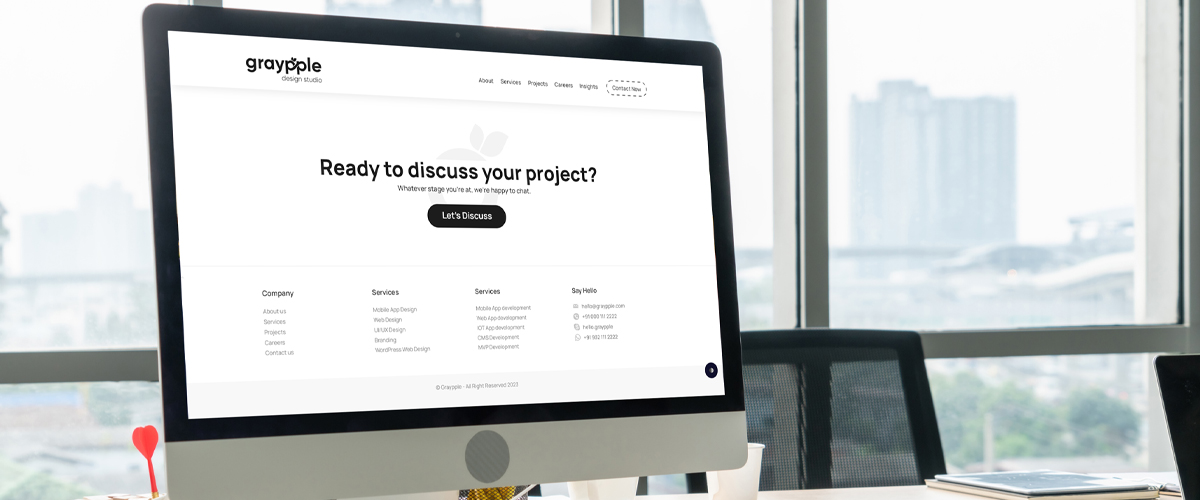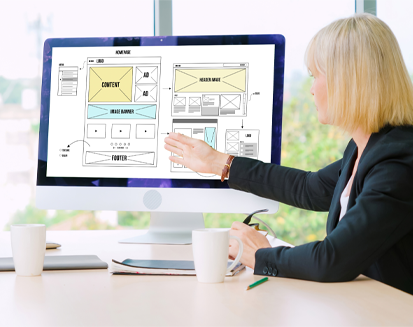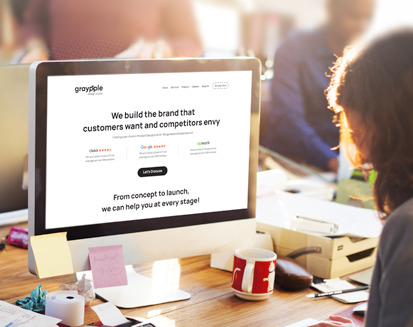The footer of a website is an often-overlooked yet crucial part of the design. It’s essential for site visitors who want to learn more about your business. The complexity of creating a website’s footer is in deciding what content to add there, with the knowledge that an optimal footer aids navigation and pushes you closer to your business goals.

We’ll look at footers in more detail in the blog to find out how to build this critical part well.
What is a Website Footer?
A website’s footer is the portion at the bottom of a page that is a hub for the site’s navigation and other essential details. It’s available in various formats, each tailored to a specific field or material.
The footer is crucial to any website since it provides customers quick access to frequently used information, including the company’s address, terms of service, contact information, and social network accounts.
The importance of the footer is highlighted by the fact that users tend to scroll through it unconsciously. However, some designers need to pay more attention to this crucial aspect of website development.
Why Website Footer is Important?
There are several reasons why website footers are so important. Some of the significant reasons are as follows:
- Easy Navigation
Essential information like contact information, privacy policies, terms of service, and more can be easily accessed through footers. If users are not able to locate the information they want promptly, they may get irritated and quit your website. A footer offers quick links for easier navigation.
- Authenticity and Assurance
Your website will seem refined with an adequately designed footer. Customers are more likely to do business with you if they can find legal and other relevant information at the bottom of your website. There is a legal need for specific information to be made available on your website, such as your privacy policy and cookie use. Including this information in the footer guarantees legal compliance.
- Supports SEO
Google and other search engines consider the footer when determining your site’s overall position. Using well-optimized keywords and links may boost your site’s ranking in search results.
- Mobile Friendliness
There are often helpful links in the footer. The footer is a more convenient place for these links than the menu bar, especially on mobile devices.
- User Expectations
As a result, site visitors have learned to rely on the footer for crucial information. They’re prepared to look farther down, making this an excellent spot for frequently sought-after content.
Advantages of Website Footer
Some of the significant features of the website footer are:
- Centralized Information
A robust footer combines essential information in one place, making it simple for consumers to find contact information, privacy rules, and more.
- Enhancing the User Interface
Incorporating appealing design, helpful information, and simple navigation tools into footers boosts UX significantly.
- Discovering Hidden Content
Users may get to both high-priority and less-visited parts of a website with internal links in the footer.
- Helps in Lead Generation
Footers can be an essential part of the sales process. For instance, the “Contact Us” box in the footer might entice site visitors to give their email addresses, generating new leads. Connecting your social media accounts might attract new fans and buyers.
- Non-Intrusive Benefits
Offering discounts for newsletter signups or other incentives to users in return for their information may be done subtly using footers.
What users can find in a website footer?
Every footer is distinct and may have a varied set of valuable elements. However, we should pay attention to the importance of following established guidelines for design. Several required elements should be included in any footer. Some of the significant elements of the website footer are-
Three Must-Haves: Copyright, Privacy Policy, and Usage Terms
These three are only sometimes prioritized by consumers, but they are critical in heavily regulated industries. Including the copyright mark and the year in your website’s footer helps deter unauthorized use of your work. Several jurisdictions mandate a Privacy Policy section on a website if it gathers personally identifiable information from users (such as emails or payment information). The Terms of Service is another important legal notification that explains the user’s obligations while using the site. These items are often located in a footer, and readers interested in them will look there.
Contacts
This component is essential in the footer if you want future leads to contact you. It’s common sense, and most site visitors seeking a way to contact you will naturally scroll down or use the footer navigation to find it. Put your company contact information there, such as your phone number, fax number, or email address. Some websites may dedicate an entire page to their contact information, depending on their niche.
Address and link to map/directions
This part is essential if you have a physical office or an offline store. Leave links to a map with coordinates and your workplace location so people may find you even when you’re not online. Don’t let your customers down by failing to provide what they expect to see.
Sitemap
The sitemap may be made available to visitors in two distinct ways. The first is to create a footer with all of the relevant links. The alternative involves adding a single connection to the sitemap in HTML format. Your site’s most vital media assets and URLs are included in the HTML map. If you want search engines to index your content-rich website more effectively, including a link to this file is a brilliant idea.
Navigation
The user experience may be amplified by adding global links to the footer. When a page is very lengthy, especially on a mobile version of the site, it might be helpful to provide links to other site sections in the footer. That will be appreciated by many of your site visitors.
Personality and Brand
The website, including the footer, should reflect the owner’s brand and personality. The site must constantly remind visitors they are dealing with a specific business. In addition to the header, the footer is a great place to showcase your brand’s identity by using your logo and corporate colors. If that is the main thrust of your marketing plan, then it should be the first thing customers notice.
Social Icons
Having a social media presence helps in more ways than just lead generation. Some companies utilize them to generate interest in and sell their products and services. So, it stands to reason to use them completely. At the bottom, link your company’s social media pages and encourage readers to follow you there.
Email Signup Form
Signing up for an email list can be a challenge for site visitors. This, however, may be utilized as a supplementary method of retaining clients by providing them with timely and pertinent information. When this is the case, a subscription form in the website’s footer is a must-have. Make sure it’s well-organized, educational, and practical. Otherwise, you risk alienating your clientele.
Site Search Tool
The search bar should be located at the top of online shops and significant websites. Remember that if a person has made it to your site’s footer, they likely have yet to discover what they were searching for in the header. Putting a search bar at the end of your pages might appease clients who have wasted time scrolling in vain. In addition, a customer might still possibly complete a transaction if they happen across the site’s search box in the footer.
Awards and certifications
If your business has been recognized for excellence, don’t be shy about telling your clientele about it. Users will have more faith in your business when such data is presented to them in a visually appealing style. Promoting your business’s wares or services via an award display with eye-catching logos is a terrific idea, and the footer is a perfect area to do it.
CTA
Your marketing page can only function with a clear Call to Action. This might be a request for someone to sign up for a newsletter, try out a trial version of a product, or even pose a query. Putting these calls to action in the footer will boost their effectiveness. They should be appealing and noticeable if you want people to engage with them.
Top 10 Website Footer Examples
Let’s take a closer look at ten excellent web page footer designs
Siteinspire
This footer has a very minimalistic approach. The site’s mission and values are laid out in the “About” section. You’ll see three areas: Most Recent Website, Information, and Contact. Four social network icons stand in for the contact information. The copyright sign is modest and located at the bottom of the page to not be a nuisance to readers.
Explain Ninja
Explain Ninja’s footer, which uses the classic design of black and white, is sleek and straightforward. The company’s name and logo are written in prominent, strong characters at the top. There are copyright and social media icons and contact information underneath the logo. Three columns on the left allow users to navigate the site, much like a traditional catalog.
Grams Caffee
Grams Caffee’s sophisticated footer was created with minimalism and readability in mind. Copyright, Terms of Service, and Privacy Policy are all included in a single, continuous phrase. The company description is included in the most visible part of the footer.
Hideout Space
Hideout Space is a one-of-a-kind spot where teams and small businesses can work and check out the area. You’ll see a simple CTA in their footer that reads “Book Now.” The design decisions that bring focus to the CTA include a centered, eye-catching button and the progressive rise of the brand above it.
Envoy
Envoy is a digital and branding consultancy. The company’s three locations are neatly shown in three separate columns in the footer. Visitors may choose from three different contact options. Links to their Instagram and LinkedIn profiles and their privacy policy and terms and conditions can be found at the bottom, all of which are correctly aligned in their columns.
Shantel Martin
The minimalist elegance of the website’s footer is a fitting complement to the site’s overall artistic excellence. The navigation is the primary emphasis, with large, prominent text highlighting the most critical parts of the site. The second section comprises social media links that may be used to learn more about the artist and their work.
Chobani.com
The bottom of the Chobani website is a striking dark green, echoing the color of the company’s name and emblem up above. Chobani has a clean, basic footer despite the vibrant overall design. The left side of the page has a subscription form for the newsletter, while the right features the navigation menu and social network sharing buttons.
Man Overboard
The website for Manoverboard is aesthetically diverse despite its essential ivory backdrop and sans-serif typeface. Consistent with this theme, the footer has a newsletter signup form alongside social media and contact information. The following parts are included at the bottom of the page: Copyright, Privacy, and Accessibility. Users may add fun by rearranging the alphabet using the mouse-controlled interactive function.
Litmus
The footer of Litmus has a minimal design and intelligent content arrangement. It has a transparent menu bar, an email address, social networking buttons, and a newsletter signup form. The footer is simple and well-organized, so users can quickly access the necessary information.
Food Sense
This is an excellent example of a creative website footer design. The footer has cartoonish images that go well with the site’s tone. It offers quick access to frequently visited pages, contact details, and a newsletter subscription form. This footer’s inventive approach makes for a more pleasurable and exciting browsing experience.
Conclusion
Designers should always pay attention to the footer. They should create a successful website by putting them in the visitors’ shoes, providing the content they need, and using your imagination in the design process.
It helps them maintain practicality, clarity, and focus. Knowing your audience and designing every element of your site, down to the footer, with them in mind is the key to a successful website.
Do you want to design an SEO-optimized and highly converting website for your business? Graypple Studio as one of the best web design agencies can help you out. We have a strong team of experienced designers and web developers holding proficiency in latest web design trends and technologies. Contact us today with your requirements and get a quote.
FAQs
Is the website Footer important?
Essential information, enhanced user experience, and higher search engine results may all be found in the website’s footer. It’s necessary for finding your way and gaining people’s confidence.
What elements should I include in my footer layout?
Include links to contact information, legal notices, relevant sites, social media accounts, and a call to action (if appropriate) in your footer. Maintain a focus on your brand and the demands of your audience.
How can I make my footer seem nice without taking up too much space?
Try with different fonts, color schemes, and layouts, but keep things simple. Focus on readability and ease of use, and ensure that your footer fits well with other website elements.


